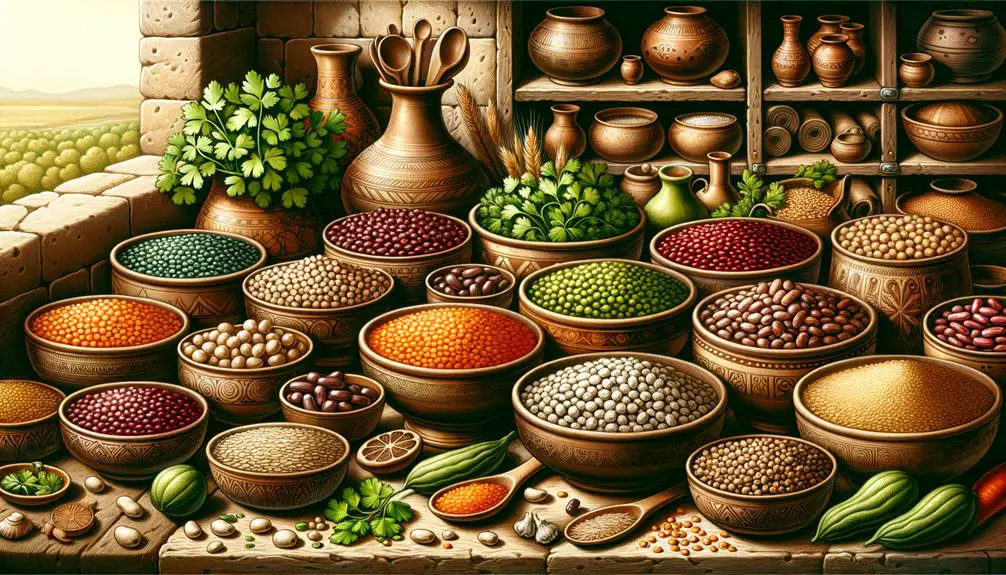A deep dive into the biblical term 'pulse,' revealing ancient dietary secrets and their significance today—discover what it truly means.

What Was Pulse in the Bible
Have you ever wondered if the 'pulse' mentioned in the Bible was merely a dietary preference or if it held a deeper significance? You're not alone in this curiosity.
The term, often overlooked, signifies more than just an ancient food choice; it's a window into the dietary practices and cultural beliefs of biblical times.
By exploring the historical and nutritional aspects of pulse, as mentioned in the story of Daniel, you'll uncover insights into its role in religious observance and its potential lessons for modern diets.
Let's embark on this journey together, where ancient texts meet contemporary health discussions.
Key Takeaways
- Pulse in the Bible refers to lentils, beans, peas, and chickpeas, serving as a dietary staple.
- Pulses provided essential proteins and nutrients, supporting predominantly vegetarian diets in biblical times.
- Daniel's choice to consume pulse over royal meats highlights its significance in religious and cultural practices.
- Historical and nutritional importance of pulses shaped ancient dietary patterns and continues to influence modern diet recommendations.
Understanding Biblical Pulse

To grasp the concept of biblical pulse, it's essential to understand its historical and cultural context within the scriptures. Pulse in the biblical sense encompasses a variety of leguminous crops that were integral to the ancient diet, primarily due to their nutritional value and ease of cultivation. When you delve into the biblical references, you'll find that pulse varieties mentioned include lentils, beans, peas, and chickpeas, among others. These were staples in the diet, providing essential proteins and nutrients in a predominantly vegetarian diet that was common among the lower classes and those who chose a simpler life for religious reasons.
The cooking methods for these pulses were as varied as the types themselves. Simple boiling was the most common technique, transforming these hard seeds into a digestible and nourishing meal. Sometimes, pulses were ground into flour, mixed with water or oil, and then cooked on hot stones or in the ashes of a fire to make flatbreads. This method allowed for a portable and durable food source, ideal for travelers and shepherds.
You'll find that understanding these cooking methods and the varieties of pulses consumed not only provides insight into the dietary practices of ancient times but also highlights the adaptability and resourcefulness of people in utilizing available resources to sustain themselves. This exploration into the preparation and consumption of pulses sheds light on the cultural significance of food in biblical times, emphasizing its role in community, tradition, and religious practices.
Historical Significance
Throughout history, pulses have played a pivotal role in shaping dietary patterns, reflecting broader socio-economic and cultural trends within biblical societies. The cultivation and consumption of pulses, including lentils, beans, and peas, were deeply intertwined with the agricultural practices of the time. These practices weren't just about sustenance but were also a reflection of the adaptability and resilience of ancient communities to their environments.
Pulses were crucial in the geographic distribution of early agricultural communities, acting as a cornerstone of food security and economy. Their ability to thrive in diverse climates and soils contributed to the spread of farming societies across the Middle East and beyond. This adaptability allowed pulses to become a staple food, supporting not just the nutritional needs of these populations but also their economic stability.
Moreover, the cultivation of pulses was closely linked with the development of agricultural technologies and methods, reflecting an understanding of crop rotation and soil health that was advanced for its time. This knowledge indicated a sophisticated approach to farming that went beyond mere subsistence, pointing to a deeper comprehension of ecological balance and sustainability.
The historical significance of pulses within biblical societies can't be understated. They were more than just a food source; they were a symbol of life and prosperity. Their cultivation and consumption reflected a complex interplay of agricultural practices, economic strategies, and geographic distribution, showcasing the ingenuity and resilience of ancient communities. As you delve deeper into the biblical references to pulses, you'll uncover layers of cultural, economic, and environmental significance that have shaped human history.
Nutritional Profile

ARTICLE TITLE: Pulse in the Bible
PREVIOUS SUBTOPIC: 'Historical Significance'
CURRENT SUBTOPIC: 'Nutritional Profile'
Pulses, often consumed in biblical times, boast a rich nutritional profile that significantly contributes to a balanced diet. These foods, encompassing a variety of legumes, were not only staples due to their availability but also due to their dense nutritional value. Understanding their components reveals why they were so valued and how, through various cooking methods, their benefits can be maximized even in contemporary alternatives.
The table below highlights the average nutritional content found in common pulses:
Nutrient |
Average Content per 100g |
% Daily Value* |
|---|---|---|
Protein |
20g |
40% |
Fiber |
16g |
64% |
Iron |
3.3mg |
18% |
Potassium |
875mg |
19% |
*% Daily Values are based on a 2,000 calorie diet.
Pulses are an excellent source of protein, making them a crucial part of vegetarian and vegan diets, both in ancient times and today. Their high fiber content aids in digestion and promotes a feeling of fullness, contributing to weight management strategies. Iron, essential for blood production, and potassium, crucial for heart health, are also abundantly found in pulses.
The cooking methods applied to pulses can affect their nutritional uptake. For instance, soaking and boiling not only make them easier to digest but also help in reducing anti-nutritional factors such as phytic acid. This enhances the bioavailability of nutrients, ensuring that the body absorbs more of these essential components. Contemporary alternatives to traditional cooking methods, like pressure cooking, offer time-saving options without significantly compromising the nutritional value, making pulses a versatile and beneficial dietary choice across different eras.
Daniel's Dietary Choice
You now turn your attention to Daniel's dietary choice, a pivotal moment that highlights the consumption of pulse as defined biblically.
This decision not only sheds light on ancient dietary practices but also invites examination of the health implications associated with such a diet.
Through analysis, you uncover the broader significance of pulse within the context of biblical narratives and its potential impact on well-being.
Pulse Defined Biblically
In the Book of Daniel, 'pulse' refers to a diet consisting solely of plant-based foods, a choice that significantly shapes the narrative's exploration of faith and identity. This term embodies a myriad of translation challenges, as the ancient texts must be navigated delicately to discern its true meaning within the context of historical agricultural practices.
The original Hebrew word, often translated to 'pulse', suggests a diet of seeds, grains, legumes, and vegetables. These elements were fundamental in ancient diets, yet their exact composition and significance can be elusive due to the evolution of language and shifts in agricultural methods over millennia.
Understanding 'pulse' in its biblical context requires a careful examination of these factors, highlighting the complexities of interpreting ancient texts in a modern light.
Health Implications
Daniel's dietary choice of consuming only pulse had profound implications for his health, offering a lens through which we can explore the nutritional and physiological impacts of a plant-based diet in an ancient context. This examination dispels contemporary misconceptions and provides insight into medical interpretations of such a diet.
Consider the following aspects:
- Nutritional Adequacy: Pulse, rich in fiber, vitamins, and minerals, contradicts the misconception that Daniel's diet was nutritionally deficient.
- Physiological Benefits: Medical interpretations suggest improved digestion and reduced disease risk, aligning with modern understandings of plant-based diets.
- Mental Clarity: The text implies a link between diet and mental acuity, challenging the misconception that a meatless diet hampers cognitive function.
These points underscore the timeless relevance and health benefits of plant-based diets.
Cultural and Religious Impacts

Analyzing the biblical mention of pulse reveals profound cultural and religious impacts that resonate through history. The integration of pulse, a term denoting seeds of legumes like lentils and beans, into biblical narratives, especially in the context of Daniel's diet, underscores its significance within ancient dietary laws and practices of religious fasting. This dietary choice, highlighted in religious texts, illustrates a deliberate abstinence from royal meats and wines to maintain purity and obedience to divine laws. It's a testament to the importance placed on food and diet as expressions of faith and devotion.
The adherence to pulse in lieu of more luxurious foods reflects a broader theme within religious discourse: the prioritization of spiritual over physical sustenance. This choice wasn't merely about health; it was a profound declaration of faith, a physical manifestation of devotion and discipline. The practice of consuming pulse, therefore, transcends mere dietary preference, embedding itself deeply within the cultural fabric of ancient societies. It served as a marker of identity, distinguishing the faithful in their adherence to divine commandments.
Moreover, the dietary laws surrounding pulse consumption have influenced religious fasting traditions that persist to this day. These practices aren't simply acts of renunciation but are imbued with spiritual significance, reinforcing communal ties and shared beliefs. They remind adherents of the importance of simplicity, purity, and the prioritization of spiritual over material needs.
Lessons for Modern Diets
The biblical endorsement of pulse offers valuable insights into the benefits of integrating plant-based foods into modern diets. This ancient dietary choice, rich in legumes and vegetables, underscores a holistic approach to nutrition that can address contemporary health issues such as obesity, heart disease, and diabetes. By analyzing this historical context, you can derive three key lessons to enhance your dietary habits:
- Embrace Garden Diversity: The variety of pulses and vegetables mentioned in biblical texts highlights the importance of diversification in your diet. Incorporating a wide range of plant-based foods ensures you receive a comprehensive spectrum of nutrients, vitamins, and minerals. This diversity not only contributes to better health outcomes but also supports sustainable agricultural practices by reducing dependency on single crop cultivation.
- Prioritize Seasonal Eating: Biblical references to pulse and other foods suggest an alignment with the natural harvest cycles. Consuming fruits and vegetables in their season maximizes the nutritional content and flavor of these foods. Seasonal eating also promotes local farming and reduces the carbon footprint associated with long-distance food transportation.
- Focus on Whole Foods: The consumption of whole, unprocessed plant-based foods as depicted in biblical times encourages a diet centered around natural ingredients. This approach minimizes intake of processed foods, which are often high in added sugars, unhealthy fats, and artificial additives, contributing to various health issues.
Adopting these principles not only fosters a healthier lifestyle but also aligns with ethical and environmental considerations, echoing the timeless wisdom found in the biblical narrative on pulse.
Frequently Asked Questions
How Has the Translation and Interpretation of the Term "Pulse" Evolved in Different Bible Versions Over the Years?
You've noticed that the term 'pulse' has shifted in Bible translations over the years, revealing diverse linguistic origins and highlighting its cultural significance.
Initially, it denoted a range of edible seeds in ancient texts. Scholars, diving into historical contexts and original languages, have nuanced its meaning, reflecting dietary habits and agricultural practices of the times.
This evolution underscores the dynamic nature of language and interpretation, offering insights into the biblical world and its people.
Were There Any Specific Types of Pulse That Were Considered Forbidden or Impure According to Other Historical Texts From the Same Era?
You're exploring if any pulse varieties were seen as forbidden or impure in historical diets according to other texts from the same era.
While the Bible doesn't label specific pulses as impure, other ancient documents might have dietary restrictions that could shed light on this topic.
It's crucial to analyze these texts critically to understand the broader historical context of dietary laws and how they influenced perceptions of purity and impurity in food.
How Did the Consumption of Pulse in Biblical Times Compare to the Consumption of Meat in Terms of Social Status or Wealth?
Ever wondered how eating habits reflected one's status in biblical times?
Pulse, primarily plant-based foods, was common among the less wealthy, contrasting sharply with meat consumption, which symbolized wealth and high status.
This divide wasn't just about preference but deeply tied to dietary laws and cooking methods of the era.
Analyzing these patterns offers insights into the societal structure, where dietary choices were a clear indicator of one's social standing.
Can the Concept of Eating Pulse as Described in the Bible Be Linked to Any Modern Vegetarian or Vegan Movements Within Religious Communities?
You might find it fascinating how the practice of eating pulse, rich in health benefits and cultural symbolism, can be connected to modern vegetarian or vegan movements within religious communities.
This link isn't just about dietary choices; it's deeply rooted in historical practices that emphasize simplicity, purity, and respect for life.
These attributes resonate with contemporary ethical and health-conscious decisions, demonstrating a continuity of values and beliefs across ages.
What Are the Environmental Implications of Growing and Consuming Pulse Crops in Ancient Times Compared to Today's Agricultural Practices?
You're exploring the environmental implications of growing and consuming pulse crops, both in ancient times and today. Historically, pulse crops likely had a lower carbon footprint and contributed positively to soil health due to less intensive farming practices.
Today, while they still benefit soil health and have a relatively low carbon footprint compared to animal agriculture, modern farming techniques can mitigate or exacerbate these effects, depending on sustainability practices employed.
Conclusion
In analyzing biblical pulse, juxtapose its modest nature against today's flashy, processed foods. Historically significant, its nutritional richness fed prophets and shaped cultures, much like fast foods mold modern societies, albeit with less virtue.
Daniel's choice underscores a deliberate preference for wholesomeness over opulence, a lesson in dietary humility. This ancient staple, contrasted with modern excess, invites reflection on our food choices' cultural and ethical dimensions, urging a return to simplicity and nourishment in our diets.



Sign up